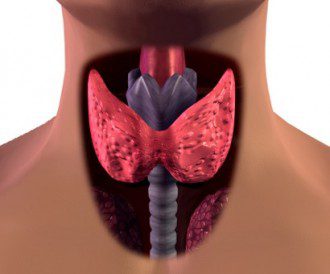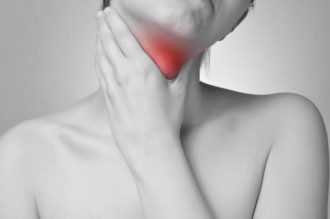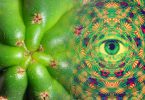By Tom Rothsey
Guest Writer for Wake Up World
Dealing with goitrogens, auto-immunity, and other thyroid disrupters
One of the first things fermentation guru Sandor Katz and I discussed when we met was the issue of goitrogenic foods in ferments. Unless you’ve been living under a rock you will have heard of the many benefits to be derived from eating fermented foods, but the idea that the cruciferous vegetables that dominate a lot of ferments contain substances that can potentially inhibit thyroid function may be new to you. The good news is that by taking care of our thyroid with the relatively simple measures outlined here, we can continue to reap the many benefits of fermented foods without compromising our health in other areas.
There has been a huge rise in hypothyroidism in recent times. Current data indicates that 12% of the population will experience some form of thyroid disorder in their lives, and this number is quietly, but steadily increasing. The thyroid gland produces a hormone that affects every single cell, tissue, and organ in the body and hypothyroidism is the condition where not enough of this hormone is produced. It is estimated that up to 90% of hypothyroidism in areas with sufficient dietary iodine has an auto-immune basis. Analysis of the year to year increase in hypothyroid conditions indicates that extrinsic or environmental factors must be the prime driving mechanism. Women are most widely affected, but the handful of studies that have quantified the rise of hypothyroidism indicate that the relative percentages of both men and young people are on the increase.
[pro_ad_display_adzone id=”110028″]
Conventional medical treatment for hypothyroidism involves either supplementation with synthetic or biologically similar thyroid hormones, or with iodine, but obviously this achieves nothing in a healing context where the causal mechanism is auto-immunity driven by external factors. As is often the case, we address the symptoms, not the cause, and if we are lucky, we will receive some dietary advice which may or may not be helpful.
Much attention has been directed by dieticians, scientists and physicians to the so called goitrogenic foods – cruciferous vegetables. Goitrogens are foods that inhibit bodily uptake of iodine, or that inhibit the utilisation of iodine by the thyroid gland, and so are implicated in hypothyroidism, related goitre formation, and thyroid cancer. Goitrogens also inhibit the transfer of iodine to breast milk. At the same time, these foods are widely touted by dieticians, scientists and physicians as having anti-inflammatory, anti-cancer, anti-oxidant, and detoxifying properties, and strangely enough, both the pro and con arguments for cruciferous vegetables revolve around the same group of compounds – the glucosinolates.
Glucosinolates are inert substances until activated by the accompanying enzyme myrosinase. In the plant tissue, glucosinolates and myrosinase are segregated, but the action of chewing breaks down the compartment walls, and the formation of what is fundamentally a range of irritant and toxic chemicals is initiated. In humans, high doses of these toxins are required to initiate substantial effects. In a nut shell, dietary iodine can allow the body to cope with low levels of isothiocyantes, but not high levels. The effects of iodine deficiency are exacerbated by a bodily lack of vitamins A and E, selenium, zinc and iron. This indicates that while crucifers confer health benefits, we should eat them sparingly if we have concerns about our thyroid, and ensure we have adequate dietary iodine, selenium, zinc, iron, and vitamins A and E. In other words, we could say treat crucifers as a medicine food that fits into a well balanced diet, one in which they are not eaten in excess.
Reduction in thyroid function may result from many factors. Habitual use of refined sugars and starches (particularly without fats or protein as balance) depletes the thyroid of hormones as these are part of the emergency blood sugar balancing response of the body; repeated exposure to endocrine disrupters that inhibit thyroid activity, the most common being fluoride in drinking water (fluoride therapy has been used to inhibit thyroid function in cases of hyperthyroidism); phytoestrogens (for example, from unfermented soy products); exposure to dioxins, PCBs, EBDCs and perchlorate; exposure to high levels of ionising radiation (includes mobile phone tower emissions, smart phones, cordless phones, wifi modems, and X-rays); stress (adrenal fatigue), and; input of hormones or their analogues through our diet or environment (for example, even food safe plastics will leach oestrogen-like compounds into our food). Disruption of thyroid function may be tied to overall hormonal imbalance, and it is worth noting that women are more likely to become hypothyroid immediately after childbirth, and after menopause. Avoidance of known external endocrine disrupters is therefore of particular importance to women, and hormonal means of birth control must be included in this consideration.
[pro_ad_display_adzone id=”110030″]
Stress deserves special consideration. Cortisol is the hormone we release in times of stress and low blood-glucose concentrations, and high levels of cortisol are associated with a factor of importance here: immune system suppression. There is a condition known as thyroid resistance, where the receptors to thyroid hormones that exist throughout our entire body are somehow shut down, and the primary cause of this is stress and high cortisol levels. If our diet contains gluten bearing grains, thyroid resistance may lead to an auto-immune thyroid condition because gliadin (the protein in gluten) is very similar to thyroid tissue at the molecular level. Unfortunately, an immune system suppressed and confused by wildly fluctuating cortisol levels all too easily attacks thyroid tissue along with gliadin because it is unable to tell the two apart. I would strongly recommend removing gluten from the diet completely if you have (or suspect you have) any thyroid or auto-immune condition, or a compromised gut and/or immune system.
Given that around 90% of hypothyroidism has an auto-immune basis, it stands to reason that eliminating substances that promote an exaggerated immune response within the body can be beneficial. Here, we are talking about things such as mercury, lead, aluminium, toluene, squalene and fluoride, many of which are used as adjuvants in vaccines precisely because an exaggerated immune response is crucial for the theory of vaccine efficacy. Hand in hand with this is the issue of chronic systemic inflammation and subsequent compromising of the immune system. Once our immune system is compromised, we increasingly lose the ability to differentiate between “me” and “other”, and so we begin to war with ourselves – healthy bodily tissues may be attacked by our immune cells as readily as pathogens and foreign bodies. Just how this translates into a recognised auto-immune condition depends on our diet, on the background state of our individual body and environment, and also on our genetic inheritance. Regardless of which auto-immune condition we present with, dealing with chronic inflammation is an essential first step on the road to health, along with steps such as minimisation of exposure to toxic substances and endocrine disruptors, replenishment of our internal micro-biota of probiotic organisms, and dietary change.

For more information, please see: The 5 Most Common Thyroid Disorders and What You Need To Know
Fermented foods, which are loaded with probiotic organisms, vitamins, digestive enzymes, and amino acids, often rely on cruciferous vegetables. Traditionally, these are associated with substantial health benefits, and much scientific research has corroborated what our ancestors observed, or knew intuitively about them. The fermentation of food does not destroy goitrogens, cruciferous vegetables need to be well boiled for an extended period to reduce the goitrogen content by 90%. But then, fermented foods are only ever intended to be a condiment, and one addition to a well balanced diet. The inclusion of cruciferous vegetables to ferments creates powerful functional foods, and there is no reason not to ferment them as long as we maintain adequate dietary inputs of iodine, selenium, zinc, iron, and vitamins A and E, and avoid known thyroid and other endocrine disruptors. Here is a list of good thyroid foods, but remember, they must be organic to be most beneficial: kelp and other seaweeds (reliable high levels of most factors, the best source), unrefined sea salt, Himalayan salt, bone broths, dark green vegetables (though some report that spinach blocks iodine absorption), butter and other dairy (preferably raw, and from grass-fed, A2 protein animals), eggs, kefir-fermented milk, yogurt, oregano, strawberries, cranberries, artichokes, asparagus, and navy beans. Seafood is not included in this list because though oceanic fish can contain good levels of essential thyroid support nutrients, as well as thyroid tissue if the head is eaten, they are also a prime dietary source of mercury, which as we have seen, is to be avoided at all costs. Oceanic fish from clean waters will be OK, but fish from the waters around heavily populated and industrialised nations are liable to contribute too much mercury to the body.
In closing, if you believe that hypothyroidism, goitrogenic foods, chronic inflammation, a compromised immune system, or endocrine disrupters may be an issue for you, consult a naturopath or a conventional doctor with a broad or holistic outlook. As well as relying on professional advice, the internet is an amazing resource (if used sensibly) that allows us to research virtually anything. This empowers us all to become our own health detectives, and to become an active participant in our own healing and well-being.
References
- American Thyroid Association (2015) Prevalence and Impact of Thyroid Disease. Website accessed 2 September 2015 at: http://www.thyroid.org/media-main/about-hypothyroidism/
- Blaylock RL (2008) A possible central mechanism in autism spectrum disorders, part 1. Alternative Therapies 14(6):46-53.
- Brown, V (2003) Disrupting a delicate balance: environmental effects on the thyroid. Environmental Health Perspectives 111(12):642-649.
- Choi AL, Sun G, Zhang Y, Grandjean P (2012) Developmental fluoride neurotoxicity: a systematic review and meta-analysis. Environmental Health Perspectives 120(10):1362-8.
- Galletti P, Joyet G (1958) Effect of fluorine on thyroidal iodine metabolism in hyperthyroidism. Journal of Clinical Endocrinology and Metabolism 18:1102- 10.
- Grandjean P, Landrigan PJ (2014) Neurobehavioural effects of developmental toxicity. Lancet Neurology 13:330-8.
- Jennings, I W (1970) Vitamins in Endocrine Metabolism. Heineman, London.
- Kempuraj D, Asadi S, Zhang B, Manola A, Hogan J, Peterson E, Theoharides TC (2010) Mercury induces inflammatory mediator release from human mast cells. Journal of Neuroinflammation 7:20
- Lopitz-Otsoa F et al. (2006) Kefir: A symbiotic yeasts-bacteria community with alleged healthy capabilities. Revisita Iberoamericana de Micología. 23:67-74.
- Luke J (1997) The Effect of Fluoride on the Physiology of the Pineal Gland. A dissertation submitted to the School of Biological Sciences, University of Surrey, in fulfillment of the requirements for the Degree of Doctor of Philosophy.
- Luke J (2001) Fluoride deposition in the aged human pineal gland. Caries Research 35:125-128.
- Masterjohn, Chris (2007) Bearers of the Cross: Crucifers in the Context of Traditional Diets and Modern Science. Wise Traditions in Food, Farming and the Healing Arts, Summer 2007.
- National Endocrine and Metabolic Diseases Information Service (NEMDIS) (2013) Hypothyroidism. Website accessed 06/02/2014: http://www.niddk.nih.gov/health-information/health-topics/endocrine/hypothyroidism/Pages/fact-sheet.aspx
- National Research Council of the National Academies (2006) Fluoride in Drinking Water: A Scientific Review of EPA’s Standards. National Academies Press, Washington DC.
- Palacios R, Sugawara I (1982). Hydrocortisone abrogates proliferation of T cells in autologous mixed lymphocyte reaction by rendering the interleukin-2 Producer T cells unresponsive to interleukin-1 and unable to synthesize the T-cell growth factor. Scandinavian Journal of Immunology 15(1):25–31.
- Peckham S, Lowery D, Spenser S (2015) Are fluoride levels in drinking water associated with hypothyroidism prevalence in England? A large observational study of GP practice data and fluoride levels in drinking water. Journal of Epidemiology and Community Health jech-2014-204971Published Online First: 24 February 2015 doi:10.1136/jech-2014-204971
- Petrik MS (2004) Behavioual and neurotoxic effects of aluminium hydroxide and squalene adjuvants in relation to amyotrophic lateral sclerosis-Gulf War illness. A thesis submitted in partial fulfilment of the requirements for the degree Master of Science, The University of British Columbia. Accessed online 2 September 2015 at: https://open.library.ubc.ca/media/download/pdf/831/1.0092770/1
- Rasmussen LB, Ovesen L, Bulow I et al. (2002) Relations between various measures of iodine intake and thyroid volume, thyroid nodularity, and serum thyroglobulin. American Journal of Clinical Nutrition 76(5):1069-76.
- Rizzo M, Rossi RT, Bonaffini O, Scisca C, Altavilla G, Calbo L, Rosanò A, Sindori A, Trimarchi F, Benvenga S (2010) Increased annual frequency of Hashimoto’s thyroiditis between the years 1988 and 2007 at a cytological unit of Sicily. Annales d’Endocrinologie 71(6):525-534.
- Rosa EAS, Heaney RK, Fenwick GR, Portas CAM (1997) Glucosinolates in Crop Plants. Horticultural Review (19) 99-215.
- Schmid, Ronald F., N.D. (1997) Traditional Foods are your Best Medicine. Healing Arts Press, Rochester VT.
- World’s Healthiest Foods (2014) Iodine. Website accessed 06/02/2014 https://web.archive.org/web/20220626055152/https://whfoods.com:443/genpage.php?dbid=69&tname=nutrient
About the author:
Tom Rothsey is an ecologist, environmental scientist, reflexologist, energy worker, health and lifestyle consultant, and teacher of the fermented arts in all their forms. He lives with his wife Christy Lavers, and their son Jasper Blue in a pole house, in a rainforest in North Eastern New South Wales, Australia.
You can connect with Tom via:
- Facebook: www.facebook.com/celestialroots
- Website: http://www.celestialroots.com
- Tumblr: http://celestialroots.tumblr.com
- Twitter: https://twitter.com/celestialroots1
- Email: [email protected]
© Copyright Tom Rothsey. This content may be freely shared on social media, or linked to on any web platform, but all other use or reproduction requires authorisation from the author. Magic is the intelligence of love.
[pro_ad_display_adzone id=”110027″]







